|
Lithography in the Pacific War - The
Harris-Seybold-Potter LTE Offset Press in Action
Harris-Seybold-Potter in World War Two
Harris - Cleveland, OH;
Seybold -
Dayton, OH;
Potter - Derby,
CT
1895-1926 - Harris
Automatic Press Company
1926-1946 -
Harris-Seybold-Potter
1946-1957 - Harris-Seybold
1957-1974 - Harris Intertype
1974-2019 - Harris Corporation
2019-Present - L3Harris
This page updated 1-13-2022.
An American Auto
Industry in World War Two Special Edition
During World War Two there were
several top secret American weapons projects. The most
well-known is the Manhattan Project, which produced the atomic bomb.
The story of this former secret project has been well documented since
the end of the war. Another top secret project, at least
until mid-war when it was reduced to confidential, was the Norden
Bombsight. It was reduced to confidential once it was known that
the bombsight had fallen into the possession of German military
authorities from American bombers shot down over Europe. After
World War Two the Norden bombsight was totally de-classified and sold as
military surplus. Many of them can be found in museums today.
NCR built the bombe computers in Dayton,
OH,
which were used to de-code the German Enigma messages. This
project continued its top secret classification for many years after
World War Two due to the technology in the bombes that could be used to
de-code top secret messages from post-war hostile nations. Persons
that worked on the project or operated the bombes were sworn to secrecy.
It wasn't until the several decades later that the project was declassified.
The only surviving bombe is on public display at the National Cryptologic Museum in
Annapolis Junction, Maryland.
However, there was another top secret project
that was developed and produced two miles away from the NCR top secret
project in Dayton, OH. This was the BEA/K-1 bomb computer and
bombsight. The development and production of this top secret
device was at the Seybold plant of Harris-Seybold-Potter at 819 West Washington
Street. The BEA/K-1
computer and bombsight remained in production and as a top secret
project after World War Two. It was not until 1970 when
Harris-Seybold donated two early models of the BEA/K1 to the National
Museum of the United States Air Force that this project became public.
That being said, there is virtually no known
history of the BEA/K1 in wartime use. Unlike the Norden
bombsight it was meant to replace, there is no literature on it nor any
BEA/K1s on display in museums. It is still unknown and by virtue of
this, still secret.

The National Museum of the United States Air
Force has two BEA/K1 bombsight computers in its possession. The
BEA/K1 was an extremely complicated electro-mechanical computer.
Photo courtesy of the National Museum of the United States Air Force.
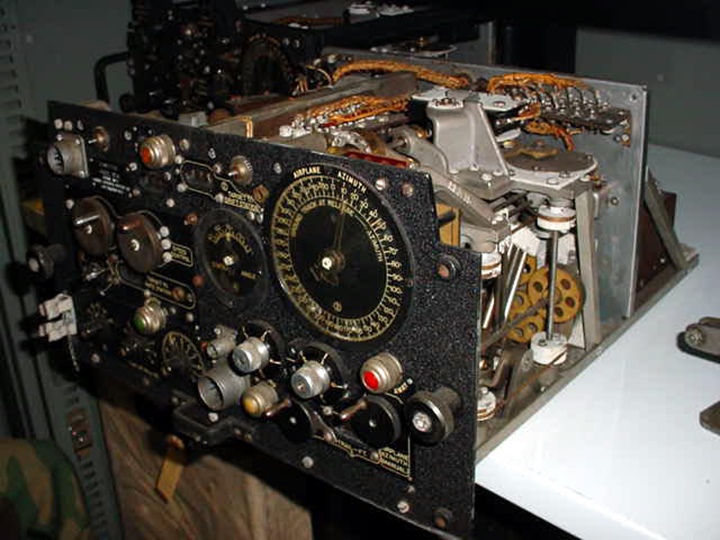
Most likely, the Seybold facility was chosen
by the Army Air Force Material Command at nearby Wright Field for two
reasons. Firstly, Seybold had demonstrated an ability to take on
diverse and difficult projects and produce them in a timely manner.
Secondly, the close proximity to
Wright Field facilitated communication on the project.
Personal communication on a project of this complexity allowed for
faster development and manufacture. Not only did the Seybold plant
do the development and prototype work, but it then received a
production contract for 250 units.
Photo courtesy of the National Museum of the
United States Air Force.
The Company
All Alfred and Charles Harris wanted to do in 1890 was to be able
to obtain advertising flyers faster for their jewelry business in Niles,
OH. Therefore, they developed an automatic feed mechanism for
printing presses that was ten time faster than manual feed systems of
the era. In 1895 they formed the Harris Automatic Press Company in
Niles, OH. The first factory was in two rooms of the same house in
which President McKinley had been born in 1843.
Today, Alfred and Charles Harris would not recognize the company nor the
company's products that still bear their name, L3Harris of Melbourne,
FL. The company exited the printing press business in 1983 and is
now a premier electronics and defense company. Nor would the
brothers have recognized the BEA/K1 bomb computer that the company
developed during World War Two. However, they would recognize the
printing press shown below. This has direct lineage back to
their products from 1895. But Alfred and Charles would approve of
the changes. Just as they were innovators and changed with the
times, so did the company that still bears their name.
The War Effort
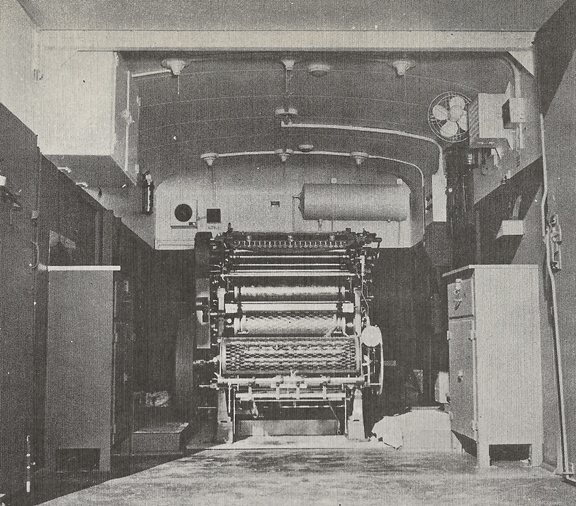
This Harris Cleveland, OH plant-built LTE press is located in the
enclosed body of a 2-1/2-ton 6x6 military truck. This was a mobile
printing press that could keep up with advancing Army units. Local
operating area maps were important to the Army soldiers.
Harris presses printed the needed maps at the location they were needed
for timely distribution to the troops. This was just one of many
applications that the Harris LTE presses performed. There was also
a need for reports and orders to be printed and distributed.
Another possible use for the Harris LTE presses was the printing of the
"Yank" newspaper which kept soldiers informed of what was
happening outside the soldiers' foxholes. Image from the September
1943 Harris Victory Review from the collection of Rich Foley.
In January 2021 I received an email from
Richard Foley of Dayton, OH. In his original and later emails, he
provided information on the company for which he once worked,
Harris-Seybold. This was a company that prior to and after
World War Two primarily manufactured printing presses and paper cutting
machines. I had never heard of Harris-Seybold until Rich's initial
email and had not thought about how a printing press company could
contribute to the winning of World War Two. Over the next few
months, I learned how much Harris-Seybold contributed to the war
effort and the diversity of its products and customers during that era.
Mr. Foley also informed me that as an employee of the Seybold plant in
Dayton, OH, he had been able to save information from the company
pertaining to World War Two. He also informed me that he had
donated this information to the local historical museum, Dayton History
at Carillon Historical Park.
This resulted in several trips for Mr. Foley and me to explore the
historical archives of Dayton History.
Without Mr. Foley's presence of mind to save historical documents and
artifacts from Harris-Seybold, this page would have been very difficult,
if not impossible
to do at all. Mr. Foley has been instrumental in making
this page a reality.
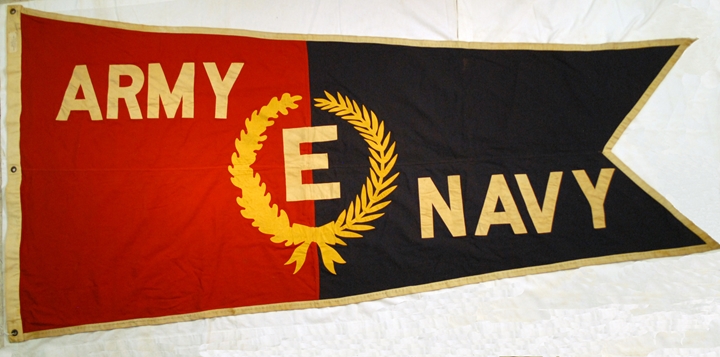
One of the artifacts Mr. Foley saved was
this original Army-Navy "E" flag that
the Seybold plant in
Dayton, OH won on December 12, 1944. He donated this to Dayton
History to be preserved for posterity. I have come across
several cases like this, where an employee is tasked with cleaning out
old documents and artifacts to be trashed, and the employee instead
saves the flag. Seybold won a second award on or about May 25,
1945. From the collections of Dayton History.
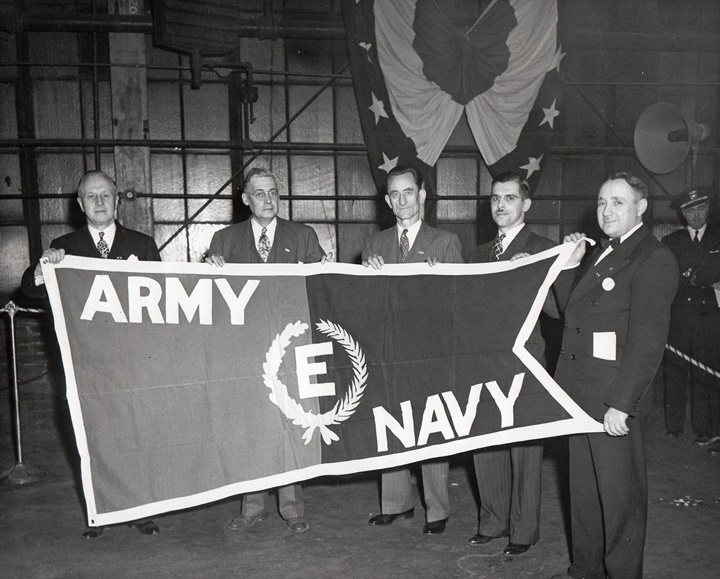
The Harris
Cleveland, OH plant also won the Army-Navy "E" two times. This
photo is from December 11, 1944, when it won the flag for the first time.
It won its second award on May 25, 1945. Photo courtesy of Rich
Foley.

The Harris plant also received this plaque
to honor its winning of the Army-Navy "E" award. Photo courtesy of
Rich Foley.
Author's Note: During the World
War Two era, the name of the company was Harris-Seybold-Potter.
However, for all intents and purposes the company was really
Harris-Seybold. The post-war booklet, "Harris-Seybold, Its War
Record," published by Harris-Seybold, makes no mention of the Derby, CT
Potter operation. I was not able to find any other historical
documentation that identified what products Potter built for the war effort.
Therefore, this page is really a Harris-Seybold page. However,
because the company was still called Harris-Seybold-Potter during World
War Two, I will use that nomenclature when referring to the company.
Harris-Seybold-Potter World War Two Products: The information
presented in this section shows the diversity of products
Harris-Seybold-Potter produced to help win World War Two.
Normally, this depth of information is not available. Harris-Seybold-Potter is a great example
of this product diversity that has been lost from many other companies.
Table 1 -
Harris-Seybold
Prime Military Contracts
The information below comes from an
early post-war booklet, "Harris-Seybold, Its War Record."
This was one of the documents saved by Mr. Foley and is now part
in the collection of Dayton History. There is no date of publication in the booklet
but is most likely 1946 or 1947.
On one
hand, the information below is a rare treasure trove of
information on what the company built to help win World War Two.
Product names, quantities, and contract numbers are all included.
On the other hand, many of the product descriptions are vague,
and do not really identify what the product really was. Also, the
booklet shows the contracted and completed amount to be
identical for both quantities. Typically, this was not the
case during World War Two. However, the information below
is invaluable for a look at what this company accomplished during
World War Two. |
|
Quantity |
Product |
Customer |
Contract Number |
Comments |
| ? |
LTE
Presses |
Army
Service Forces, Corps of Engineers |
W-11-114 ENG. (MSP) 790 |
Built
at the Harris Cleveland Plant.
These were an important piece of equipment for the making of
maps in the war zones. |
| 792 |
M4/M4A1 Tank Controls |
Pressed Steel Car Company |
W-271-ORD-717 |
These
were for the Pressed Steel-built M4/M4A1 Sherman tanks. The
M4/M4A1 was the preferred version of Sherman tank for the first
2.5 years of the war. |
| 60 |
Radar
Units |
Navy
Department |
NXso-21252 |
Harris-Seybold-Potter built the mechanical geared systems that
allowed the shipboard radar units to rotate and elevate to track
enemy ships and aircraft. |
| 100 |
Radar
Units |
Navy
Department |
NOrd-3971 |
Harris-Seybold-Potter built the mechanical geared systems that
allowed the shipboard radar units to rotate and elevate to track
enemy ships and aircraft. |
| 538 |
Spindles, elevating arcs, covers, and associated equipment for
827 radar antenna mounts |
Navy
Department |
NOrd-5879 |
Built
at the Harris Cleveland Plant.
Harris-Seybold-Potter built the mechanical geared systems that
allowed the shipboard radar units to rotate and elevate to track
enemy ships and aircraft. |
| 185 |
Radar
Units |
Navy
Department |
NOrd-6026 |
Harris-Seybold-Potter built the mechanical geared systems that
allowed the shipboard radar units to rotate and elevate to track
enemy ships and aircraft. |
| 1,000 |
M-10
Recoil Mechanisms |
War
Department, Cleveland Ordnance District |
W-303-ORD-1209 |
Built at the Harris Cleveland Plant.
These were the recoil mechanisms for the M10 Wolverine tank
destroyer. |
| 100 |
57mm
Anti-Tank Gun M-12 Recoil Mechanisms |
War
Department, Cleveland Ordnance District |
W-303-ORD-1658 |
This
was a small number of recoil mechanisms compared to the 16,637
57mm anti-tank guns that were built. |
| 50 |
Servo
Units |
Navy
Department |
NOrd-7062 |
Harris-Seybold-Potter built the mechanical geared systems that
allowed the shipboard radar units to rotate and elevate to track
enemy ships and aircraft. |
| 3,950 |
Servo
Units |
Navy
Department |
NOrd-8130 |
Harris-Seybold-Potter built the mechanical geared systems that
allowed the shipboard radar units to rotate and elevate to track
enemy ships and aircraft. |
| 3,000 |
Control Units for Project Pelican |
Navy
Department |
NOrd-4813 |
The
Pelican was a 1,000 pound guided bomb that never got out of the
development program and was cancelled in 1944 after two years of
limited testing. Only a few were built. It is
unlikely 3,000 units were actually built. |
| 900 |
Control Units for Project Bat |
Navy
Department |
NOrd-6412 |
This
weapon was the operational guided bomb for the U.S. Navy during World War Two
and was derived from the early Project Pelican. However,
it only saw limited use with 33 launched during the war.
It is unknown whether the 900 originally contracted control
units were actually built. |
|
120,000 |
Stereoscopic Relief Prints |
Navy
Department |
NXsa-20687 |
|
| 1 |
TBF
Avenger Turret Mock-up Model |
Navy
- Bureau of Aeronautics |
NOa(s)-1457 |
Built
at the Harris Cleveland Plant.
The Navy must have needed this for a special display. |
| 201 |
Five-Inch/25 Caliber Wet Gun Mounts for Submarine Use |
Navy
Department |
NOrd-4461 |
Built at the Harris Dayton Plant. |
| 100 |
Propeller Stands |
Wright Field, USAAF |
W-535-ac-22871 |
Built at the Harris Dayton Plant.
These
were actually propeller blade stands and looked like a picnic
table benches. |
| 600 |
Propeller Stands |
Wright Field, USAAF |
W-535-ac-27733 |
Built at the Harris Dayton Plant.
Same
as above. |
| 5,000 |
Cam
Limit Stops |
Navy
Department |
NOrd-7096 |
This
is very well defined. |
| 8,000 |
Cam
Limit Stops |
Navy
Department |
NOrd-5554 |
This
is very well defined. |
| 10,000 |
Cam
Limit Stops |
Navy
Department |
NOrd-5364 |
This
is very well defined. |
| 200 |
Computer Assemblies |
Army
Air Forces |
W-33-038 ac-627 |
Built at the Harris Dayton Plant. |
| 2 |
Experimental Models of BEA-AN/APN-3 |
Army
Air Forces |
W-535
ac-33682 |
Built at the Harris Dayton Plant.
This was the top secret bomb release computer. The
AN/APN-3 was a Shoran based system. |
| 250 |
Computer Assemblies |
Army
Air Forces |
W-33-038 ac-7701 |
Built at the Harris Dayton Plant.
This was the top secret tK1 bomb release computer. The
AN/APN-3 was a Shoran based system. |
| 1000 |
Elevating Arcs |
Navy
Department |
NOrd-7069 |
Elevating arcs were used in the three-inch dual purpose gun that
was used in destroyer escorts, LSTs, and Merchant Marine ships.
Elevating arcs were also used in
the Navy's five-inch dual purpose gun that was used on all
fighting ships larger than a destroyer escort. These were
the main guns and destroyers. Cruisers, battleships, and
aircraft carriers were all armed with five-inch guns.
Harris-Seybold-Potter probably
made elevating arcs for both types of weapons. |
| 600 |
Elevating Arcs |
Navy
Department |
NOrd-7946 |
Same
as above. |
| 1000 |
Elevating Arcs |
Navy
Department |
NOrd-4473 |
Same
as above. |
| 200 |
Elevating Arcs |
Navy
Department |
NOrd-9194 |
Same
as above. |
| 2,500 |
3-Inch Fuze Setters and Spare Parts |
Navy
Department |
NOrd-939 |
The three-inch dual purpose gun that
was used in destroyer escorts, LSTs, and Merchant Marine ships.
|
| 1,750 |
3-Inch Fuze Setters and Spare Parts |
Navy
Department |
NOrd-4858 |
Same
as above. |
|
Table 2 -
Machine Tools built for Other Companies |
|
Quantity |
Type |
Location |
| Over
250 |
Bullard Vertical Boring Machines |
Built
at the Harris Cleveland Plant. |
| |
Wickman Screw Machine Lathes |
Built at the Harris Dayton Plant. |
| |
Hartinge Precision Lathes |
Built at the Harris Dayton Plant. |
| |
Morrison Metal Stitching Machines |
Built at the Harris Dayton Plant. |
Companies Harris-Seybold had sub-contracts
with:
Akron Standard Mold, Allen Bradley Company,
Allen Tool & Mfg. Company, Babcock Wilson Company, Bell Industries, Bell
Sound System, Bendix Corporation, Briggs Manufacturing Company, Broat
Pattern & Casting Company, Cincinnati Gear Company, Cort Engineering and
Manufacturing Company, Crucible Steel Company, Cutler Hammer, Inc.,
Dayton Aircraft, Inc., Dayton Rubber Company, Diamond Machine Company,
Eclipse Pioneer Division of Bendix Corporation, Emerson Electric
Company, Fafair Bearings, Inc, Fawick Airflex Company, Federal Gear
Company, General Aluminum Company, Goodyear Aircraft Corporation,
Hoffman Sheet Metal Company, Hooper Transmission Company, Joseph T.
Ryerson & Sons, Kin-E-matic Machine Company, Lear, Inc., Leece-Neville
Company, New Departure Division of General Motors, Option Laboratories,
P.R. Mallory Company, Piqua Engineering, R.C. Allen Company Strong,
Carlisle & Hammond, Reynolds Metal Company, Rocket Machine Company,
Scientiae, Struthers Wells Company, Veeder-Root Company, Westinghouse
Electric Corporation.
Harris-Seybold Machine Tools: The reason that
Harris-Seybold-Potter was able to make a variety of products for many
different customers during World War Two was that the manufacture of
printing presses required well equipped tool rooms. So, when the
war came, the Harris plant in Cleveland and the Seybold plant in Dayton
were able to manufacture a variety of products.
Both the Cleveland and Dayton factories also
had their own gray metal cast iron foundries and pattern shops.
This allowed both locations to make the castings and then do the final
machining at one location.
|
Table 3 -
Harris-Seybold Machine Tools |
| Tool
Type |
Quantity
at Harris Plant, Cleveland, OH |
Quantity at Seybold Plant, Dayton, OH |
|
Single Spindle Drill Press |
15 |
9 |
|
Multi-Spindle Drill Press |
10 |
|
|
Radial Drills |
10 |
12 |
|
Sensitive Drills |
|
10 |
| Fixed
Bed Milling Machines |
5 |
|
| Jig
Borers |
3 |
|
|
Horizontal Boring Mills |
3 |
5 |
|
Verticlal Milling Machines |
10 |
|
|
Horizontal Milling Machines |
13 |
16 |
|
Miscellaneous Milling Machines |
5 |
6 |
|
Hydrotel Type Milling Machines |
|
2 |
|
Engine Lathes |
|
10 |
|
Horizontal, Bar Type Turret Lathes |
12 |
|
|
Horizontal, Chuck Type Turret Lathes |
10 |
|
|
Bullard Lathes |
|
4 |
|
Vertical Turret Lathes |
4 |
9 |
|
Cylindrical Grinders |
7 |
4 |
|
Internal Grinders |
1 |
|
|
Surface Grinders |
1 |
5 |
|
Centerline Grinders |
|
1 |
| Disk
Grinders |
|
3 |
|
Polishers |
8 |
|
| Gear
Cutters |
9 |
3 |
| Gear
Hobbers |
|
4 |
| Gear
Shapers |
|
2 |
| Gear
Shavers |
|
1 |
| Large
Planers |
|
7 |
| Small
Planers |
|
8 |
| Small
Hand Screw Machines |
|
4 |
| Small
Hand Feed Screw Machines |
|
2 |
|
Automatic Screw Machines |
|
1 |
| Large
Head Screw Machines |
|
5 |
| Broaches |
|
2 |
|
Shapers |
|
2 |
Product Photos:

The Cleveland plant built 750 LTE 20x22
single color offset printing presses for the Army Corps of Engineers
during World War Two. From the collections of Dayton History.
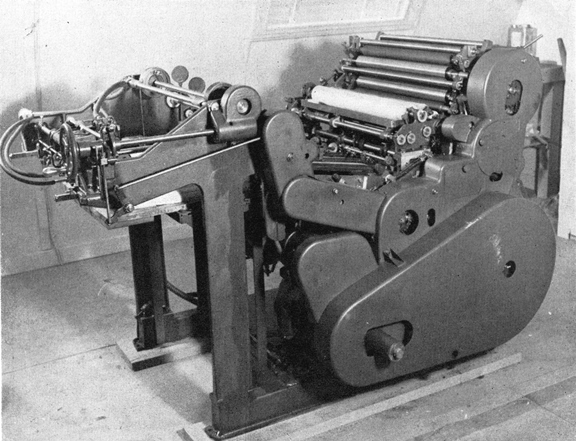
This shows the reverse side of the LTE.
Photo courtesy of Richard Foley added 1-8-2022.
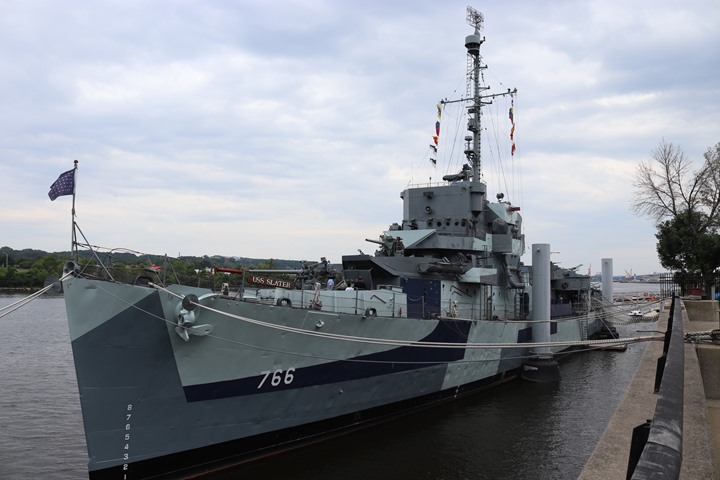
This is the USS Slater on the Hudson River in
Albany, NY. This is the most well restored World War Two warship
on display in the United States. Author's photo.
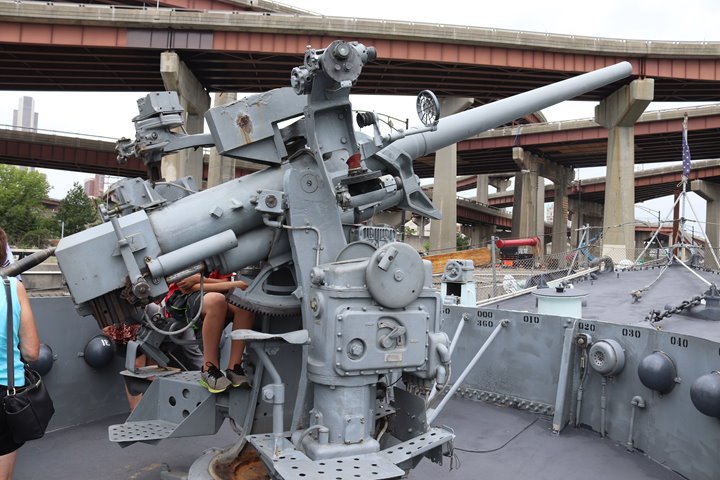
This is the number one three-inch gun on the
USS Slater. Part of the geared elevating arc is visible under the
weapon's recoil mechanism. The fuze setter is on the opposite side
of the weapon. Author's photo.
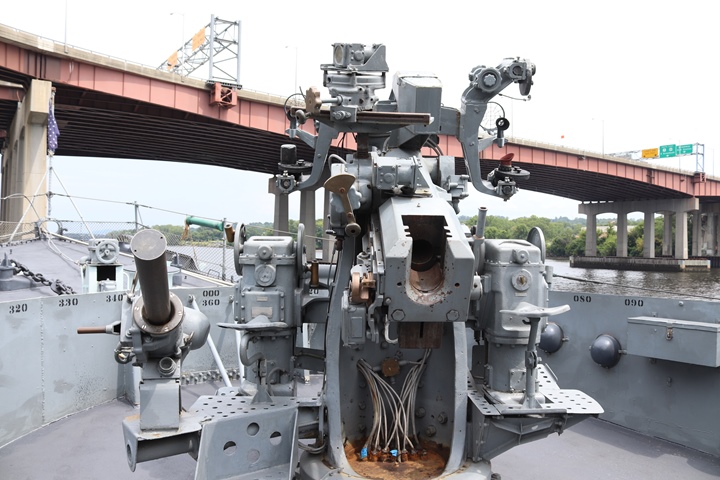
A fuze
setter for the three-inch shell is On the left side of the weapon. Author's photo.
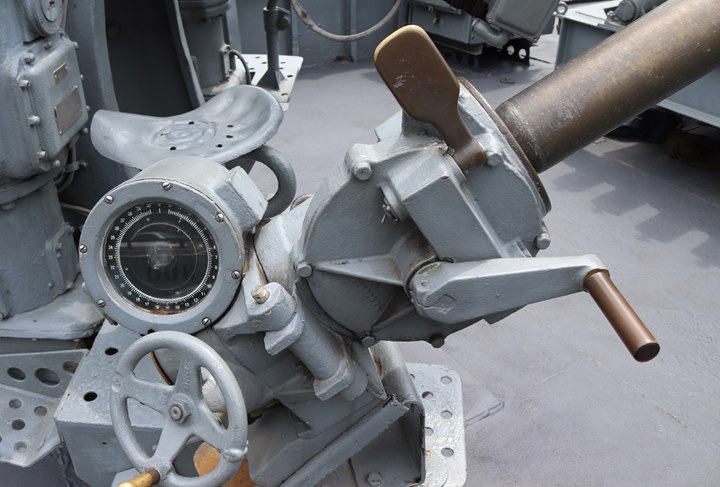
Harris-Seybold made 4,250 of the three-inch
fuze setters for the U.S. Navy during World War Two. With that
many made, this could very well be a Harris-Seybold unit. The fuze
setter is an assembly of castings with internal parts. Both the
Cleveland and Dayton plants had the capability to make the patterns,
cast the parts, and then machine them to final tolerances and assemble them. Author's photo.
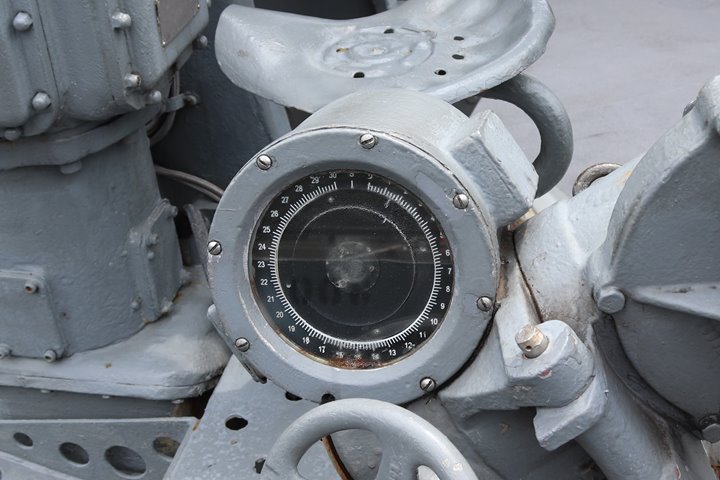
The dial pointer could designate the
range of the projectile before exploding to the nearest two hundred
feet. Author's photo.
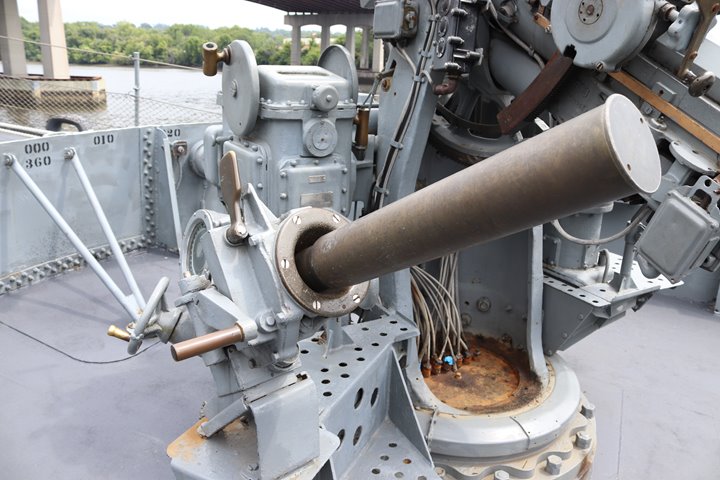
The fuze setter was used when the weapon was
used as an anti-aircraft gun. The distance to target was estimated
and the fuze was set for that amount of distance. This information
was furnished to the gun crew from the sailors operating the range finders.
Author's photo.
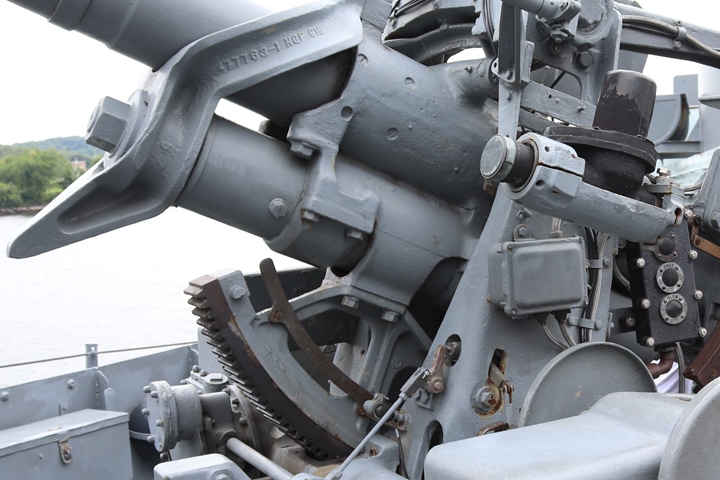
Harris-Seybold-Potter had four contracts from the U.S. Navy totaling 2,800
elevating arcs. The elevating arc on the three-inch gun was
attached to a large casting by four bolts that encased the barrel and
recoil mechanism. Author's photo.
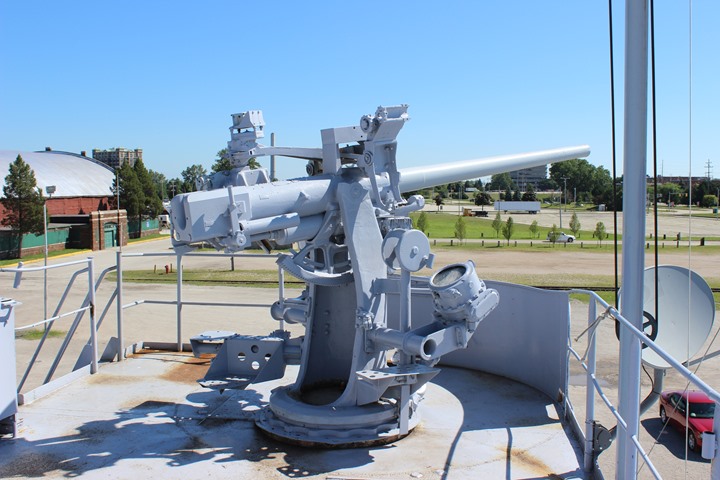
This three-inch gun on LST 393 in Muskegon,
MI reveals the Harris-Seybold-Potter-built elevating arc underneath the
barrel of the weapon. Author's photo.
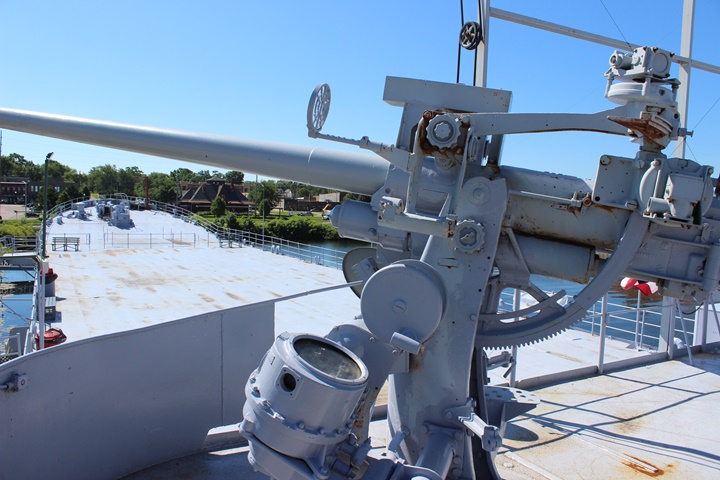
The elevating arc for the three-inch
gun consisted of several castings and a stamped part assembled together.
This photo gives a good view of the rear of the elevating arc and how it
connects to the rear of the weapon. Author's photo.
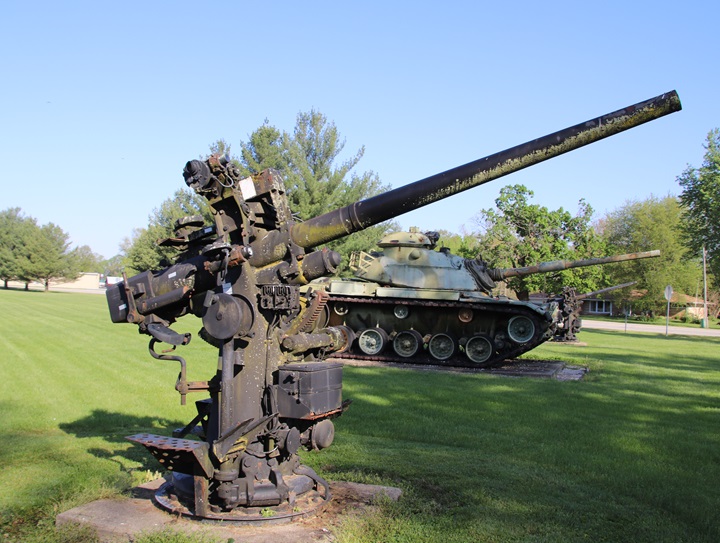
This three-inch dual purpose gun is on
display at the American Legion in Shelburne, IN and shows the front of
the elevating arc. Author's photo.

This view of the elevating arc shows the
gears cut into two castings and the markings on the stamped part.
The entire elevating arc consists of at least four castings. Both
the Cleveland and Dayton plants had the ability to cut the gears for this
device. Author's photo.
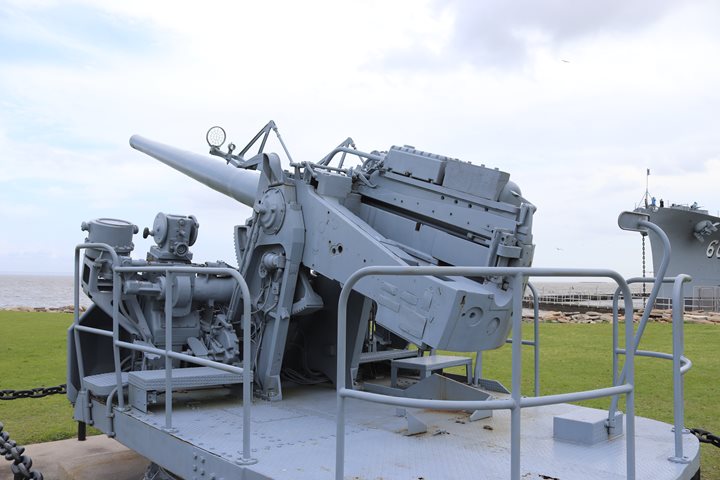
This five-inch, 38 caliber gun is on display
at the USS Alabama in Mobile, AL. Both ends of the elevating arc
on the weapon can be seen. This is a much larger unit than the
ones utilized for the smaller three-inch gun. The U.S. Navy had
larger guns that had elevating arcs up to sixteen inches, which would
have been extremely large units. These may have been beyond
Harris-Seybold-Potter's capability to produce. Author's photo.

This five-inch, 38 caliber gun can be
seen at the USS Sullivans at the Buffalo and Erie County Naval and
Military Park in Buffalo, NY. This is the more familiar form of a
five-inch naval gun from World War Two. Author's photo.
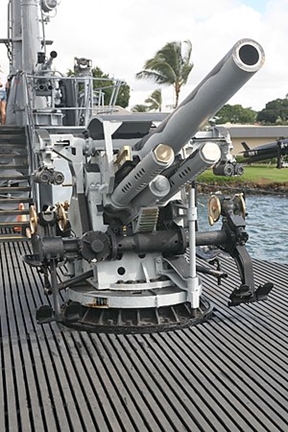
The U.S. Navy was a big customer of
Harris-Seybold-Potter during World War Two. The company produced
201 wet mounts for the five-inch deck guns on U.S. Navy submarines.
These mounts were required to function properly after being immersed in salt
water for long periods of time.
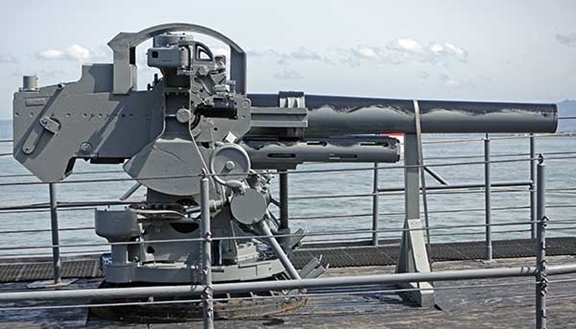

Harris-Seybold-Potter built control units
for both the U.S. Navy's Pelican and Bat guided glide bombs. The
Pelican program was terminated while still in the testing phase.
However, the ASM-N-2 Bat did go into production and was used in very
limited combat late in the war. Between April and July 1945, 33
Bats were launched at targets. Four were hits, one of which
severely damaged the bow of a Japanese escort ship. The ASM-N-2
Bat carried a 1,000 pound warhead and had a range of fifteen miles.
It was guided to its target by a radar seeker in its nose.

As the Bat approached the target, the radar
seeker in the nose of the weapon sent correction signals to the
Harris-Seybold-Potter-built control unit. While the use of guided
bombs was in its infancy during World War Two, it was high-tech for the
era. Harris-Seybold-Potter was a part of this high tech
revolution. From the collections of Dayton History.
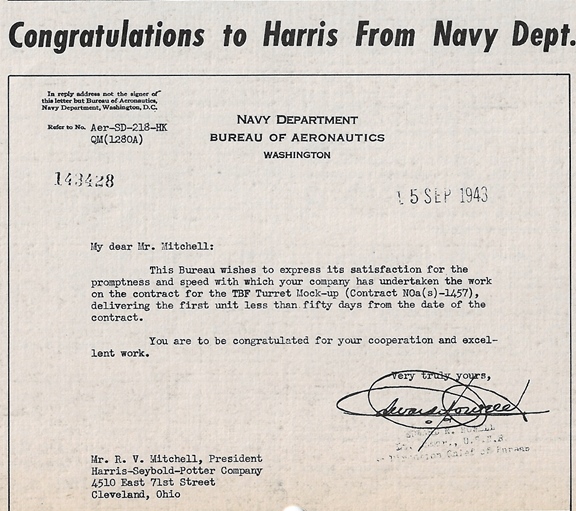
In 1943 Harris-Seybold-Potter built one TBF
turret mock-up. Company records indicate only this one was built.
However, this letter implies that this was the first of several.
Production of the actual turret had been in production since before
Pearl Harbor. In 1943 the General Motors Eastern Aircraft Division
was producing the license-built TBM in volume and Emerson Electric was
building the turrets. It is unknown why a mock-up was needed when
the actual turrets were in production. Image from the September
1943 Harris Victory Review from the collection of Rich Foley.

This and the next three photos show an
actual TBM turret. It is unknown how much detail and functionality
the mock-up contained. Its purpose is unknown. Author's
photo from the
New England Air Museum.
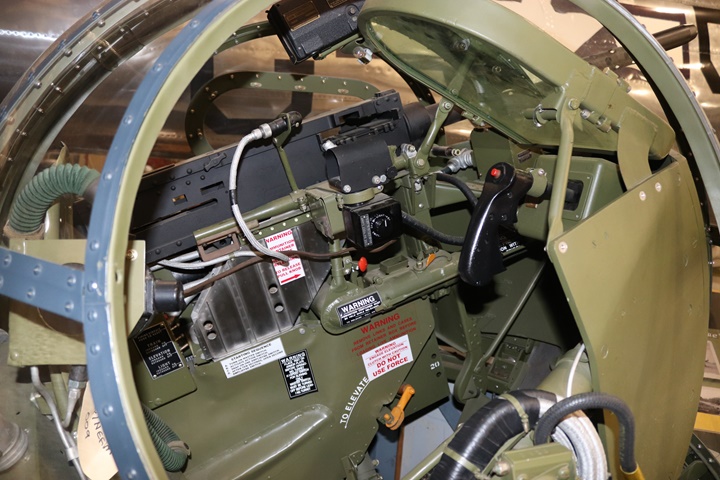
Author's photo from the
New England Air Museum.
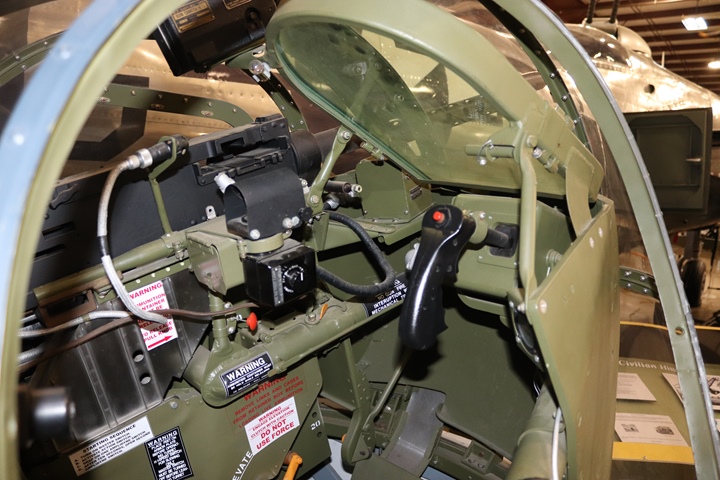
Author's photo from the
New England Air Museum.

Author's photo from the
New England Air Museum.

This un-restored TBM turret at the Liberty
Aviation Museum in Port Clinton, OH shows that the framework of the
turret was formed steel pipe. Author's photo
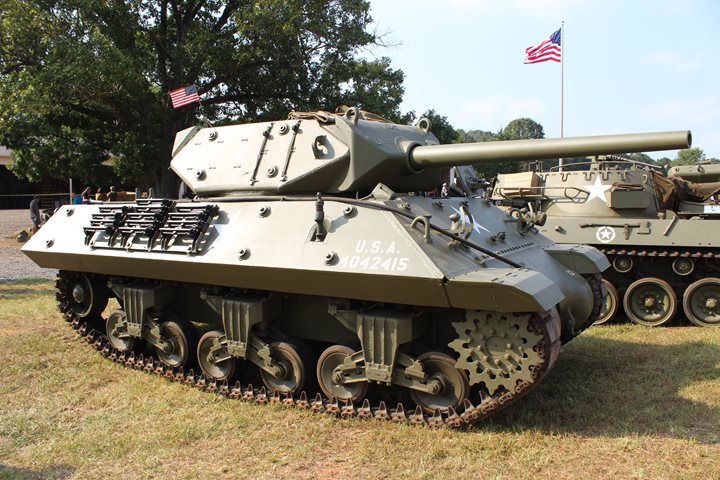
This Fisher Body-built M10 Wolverine is
armed with a three-inch main gun. The Harris Cleveland plant built 1,000
recoil mechanisms for this weapon. The M10 was the main
self-propelled anti-tank gun used by the U.S. Army during World War Two.
It began its combat service in North Africa and served in Sicily, Italy,
northeast Europe, and the Philippines. There were a total of 6,406
M10 and M10A1s built during World War Two. Author's photo.
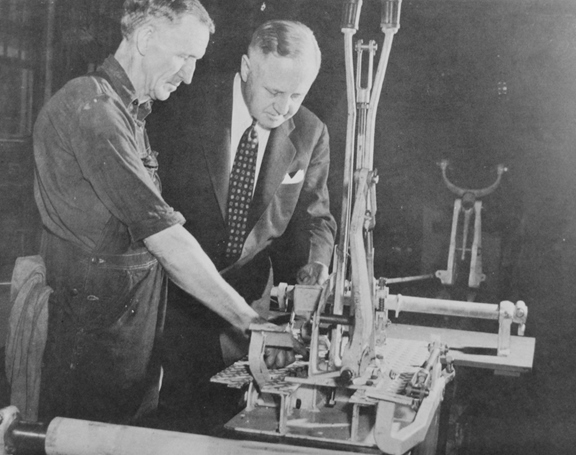
Harris-Seybold-Potter built 792 tank
controls for the Pressed Steel Company of Chicago, IL which built the M4, M4A1, and M4A2
Sherman medium tank. The two long levers are the
steering brakes. The driver pulled back on the one for the
direction he wished to steer the tank. This applied the brakes to
the drive mechanism for that side of the tank. To slow down or
stop, both levers were pulled to the rear. This was not easy work
for the driver. I have seen videos of restored Sherman tanks
showing the driver pulling back on the brakes. Many times, they used both arms to pull one of them back and turn the tank. Good
upper arm and shoulder strength in a driver was a big plus.
The tank control shown here also includes the
gas clutch pedals. It was a true control assembly. From the
collections of Dayton History.
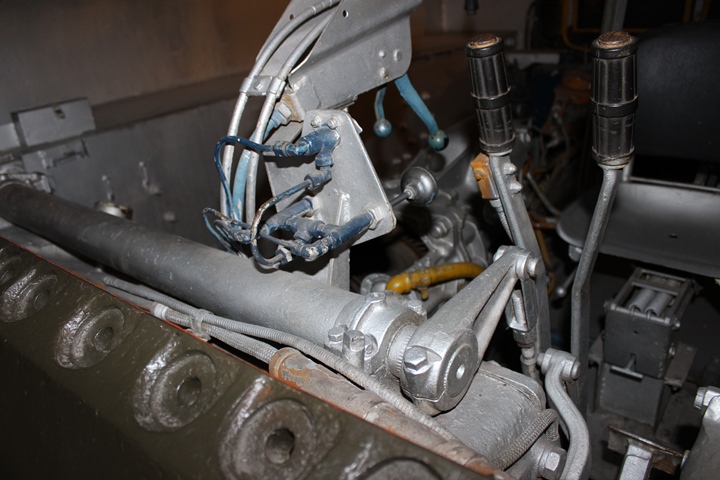
Here are the two upper ends and hand grips
on the steering brakes in an M4A2 Sherman tank at the Canada War Museum.
Author's photo.
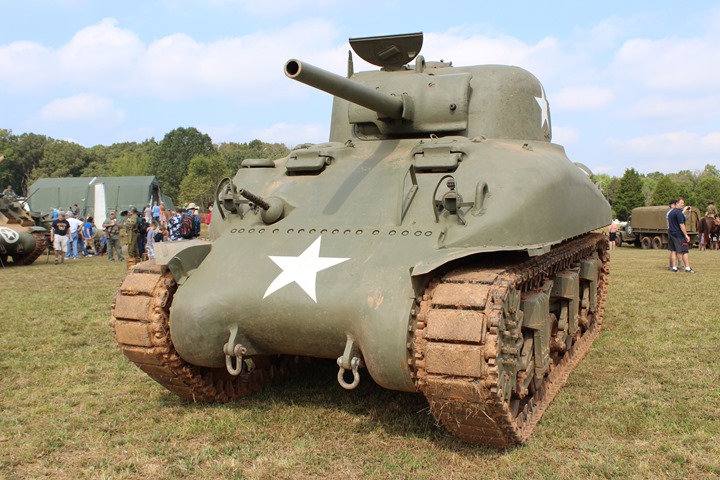
The 792 tank controls built by Harris-Seybold-Potter could have gone into
any of several of the Sherman tanks built by Pressed Steel. This Pressed Steel-built small hatch
M4A1(75) is serial number 192, built in July 1942. It
is USA number 3014948. It is the oldest Pressed Steel
M4A1(75) known to exist and is owned by the Virginia Military Museum of
Military Vehicles. The tank controls could have been used
in a tank like this. Author's photo.

This
M4E9(75) was built by Pressed Steel and is on display at the USS Alabama
in Mobile, AL. This was the welded version of the Sherman. Harris-Seybold-Potter-built tank controls were in
tanks that were used in all the campaigns and many important battles.
Author's photo.

Harris-Seybold-Potter built 100 recoil
mechanisms for the 57mm anti-tank gun. Author's photo.

Harris-Seybold-Potter machined several of
the small parts used in the Allison V-1710 aircraft engine. The
engine was used in the both the P-40 and P-38 fighters of World War Two.
Author's photo.
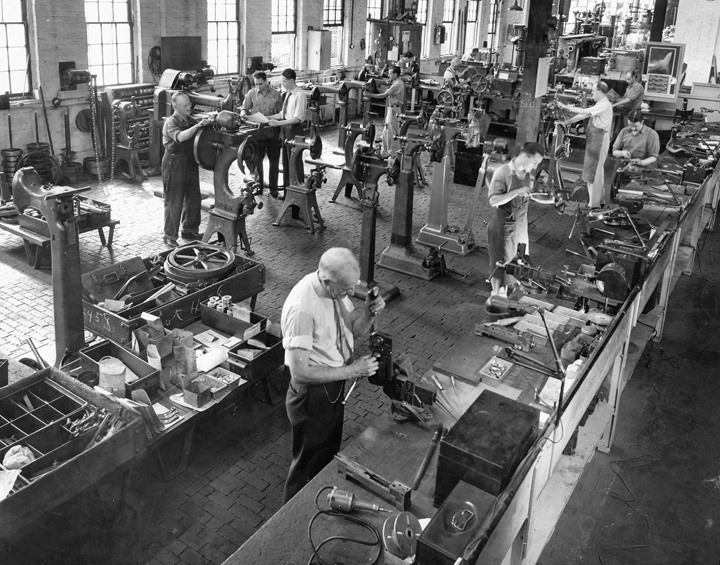
Morrison Stitchers developed by the Dayton
Seybold plant were not shown in any of the contracts in Table 1. In
the background, workers can be seen assembling these machines. Aviation companies
used these to replace rivets in many
applications. The Morrison Stitcher was a faster and more
efficient way to fasten two parts together. Photo courtesy of Rich
Foley.
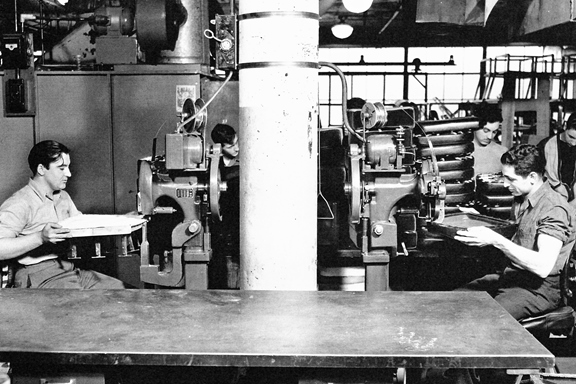
Two Seybold workers in the Dayton plant are
using Morrison stitchers to fasten different components together.
Photo courtesy of Rich Foley.
The Plants:
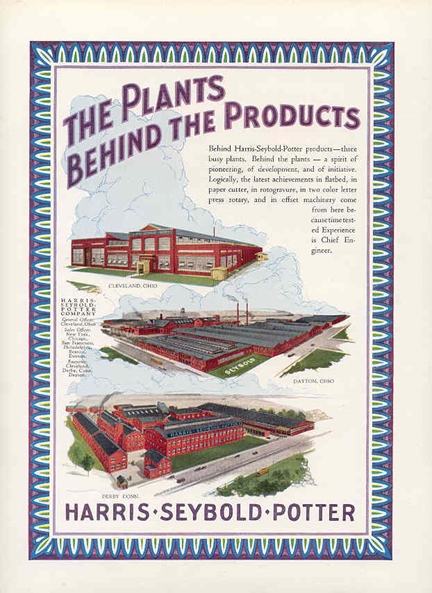
This artist's water color rendering shows the
factory's red brick construction. It shows how large the Seybold plant was. Photo
courtesy of Rich Foley.

This beautiful water color rendering of the Dayton plant is looking
northwest with Washington Street at the bottom of the picture.
This plant had its beginnings in 1893 as the Seybold Machine Company.
This image added 1-13-2022 is courtesy of Richard Foley.
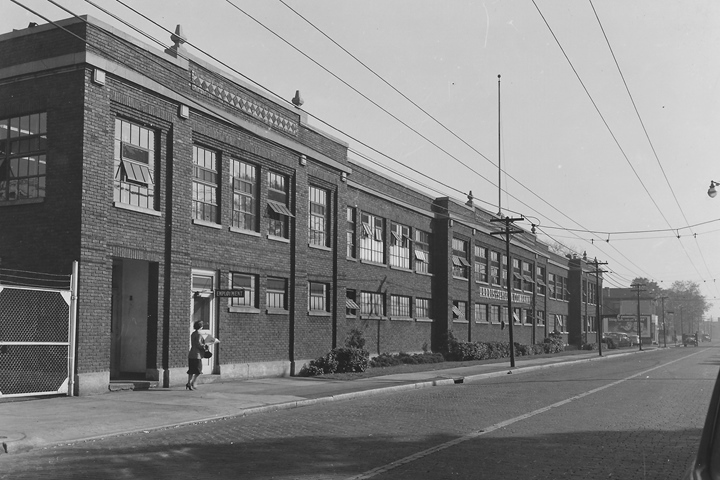
This is the former Dayton Seybold plant at
819 West Washington Street looking east. The plant was razed and today
the Ponitz Career Technology
Center occupies the property.
This plant employed
between 600-1,500 workers, depending on the work load. The plant had a
cast iron foundry with pattern making capabilities. Its primary
products were for the book binding industry to include guillotine paper
cutters, stitchers, and trimmers. Photo courtesy of Rich Foley.
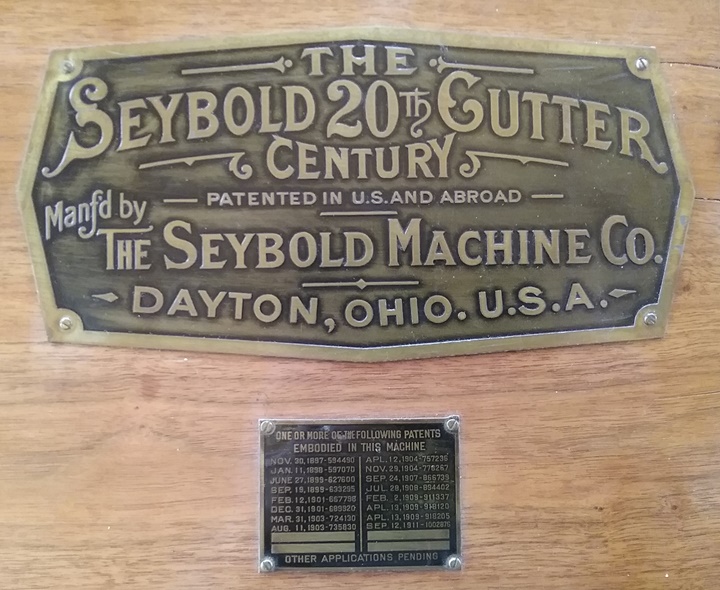
Photo courtesy of Rich Foley.
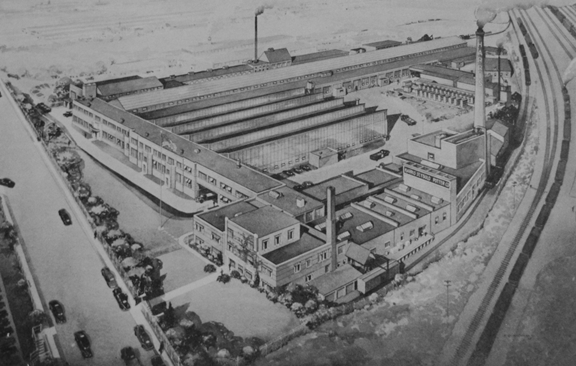
This is an artist's rendering of the Cleveland plant of
Harris-Seybold-Potter. It specialized in offset printing presses
and employed between 600-1,500 workers. From the collections of
Dayton History.
|












































